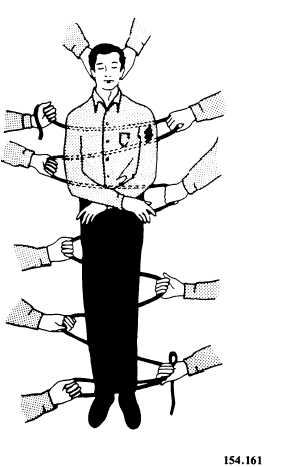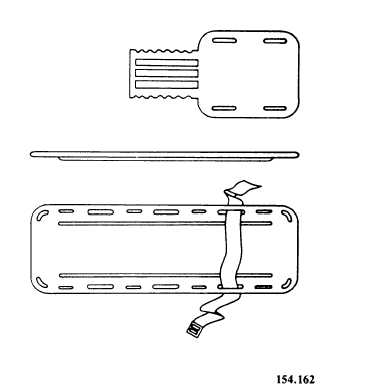CAUTION: Many improvised stretchers do not give sufficient support in cases where there are fractures or extensive wounds of the body. They should be used only when the casualty is able to stand some sagging, bending, or twisting without serious consequences. An example of this type of improvised stretcher would be one made of 40 to 50 feet of rope or 1 1/2-inch firehose (fig. 4-82).

Figure 4-82.—Improvised stretcher using rope or firehose.

Figure 4-83.—Spineboards.
SPINEBOARDS.— Spineboards are essential equipment in the immobilization of suspected or real fractures of the spinal column. Made of fiberglass or exterior plywood, they come in two sizes, short (18" x 32") and long (18" x 72"), and are provided with handholds and straps, and have a runner on the bottom to allow clearance to lift (fig. 4-83).
A short spineboard is primarily used in extrication of sitting victims, especially in automobile wrecks, where it would be difficult to maneuver
the victim out of position without doing additional damage to the spine. The long board makes a firm litter, protecting the back and neck, and providing a good surface for CPR and a good sliding surface for difficult extrications. The short and long boards are often used together. For example, at an automobile accident site, the corpsman’s first task is to assess the whole situation and to plan the rescue. If bystanders must be used, it is essential that they be thoroughly briefed, in detail, on what you want them to do. After all accessible bleeding has been controlled and the fractures splinted, the short spineboard should be moved into position behind the victim. A neck collar should be applied in all cases and will aid in the immobilization of the head and neck. The head should then be secured to the board with a headband or a 6-inch self-adhering roller bandage. The victim’s body is then secured to the board by use of the supplied straps around the chest and thighs. The victim may then be lifted out. If, however, the victim is too large, or further immobilization of the lower extremities is necessary, the long spineboard may be slid at a right angle behind the short spineboard, and the victim is maneuvered onto his or her side and secured to the long board.
The possible uses of the spineboard in an emergency situation are limited only by the imagination of the rescuers.
